A weight bench is a fantastic addition to any home gym. But as a beginner, you may be hesitant about investing the space and money for a bench. So how do you bench press and train your chest without a bench? I’ll be sharing 15 ideas for a weight bench alternative you can use at home!
Key Points Summary:
| Weight Bench Alternative | Comfort | Safety | Weight Capacity | Difficulty |
|---|---|---|---|---|
| Piano bench | Good | Ok | Good | Easy |
| Plywood stack | Ok | Great | Great | Easy |
| Couch armrest | Very bad | Bad | Bad | Hard |
| Mattress corner | Great | Great | Bad | Hard |
| Coffee table | Good | Ok | Ok | Ok |
| Exercise ball | Great | Good | Good | Hard |
| 2 chairs and bed slats | Ok | Bad | Good | Ok |
| Line of stools | Bad | Very bad | Ok | Hard |
| Rice sack | Great | Great | Great | Easy |
| Reclinable deck chair | Great | Very bad | Very bad | Easy |
| Mini bookcase | Ok | Ok | Bad | Ok |
| Stack of books | Ok | Great | Great | Ok |
| Half-cut log | Very bad | Good | Great | Hard |
| Stack of pillows | Great | Great | Great | Easy |
| Floor | Great | Great | Great | Easy |
Disclaimer: whilst I’ve used many of the methods mentioned here onwards, and deem them safe, using a makeshift bench still carries inherent risks. I have done my best to highlight any areas of potential risk. But you should still be diligent yourself and be as safe as possible! I would always recommend a proper bench over a DIY where possible.
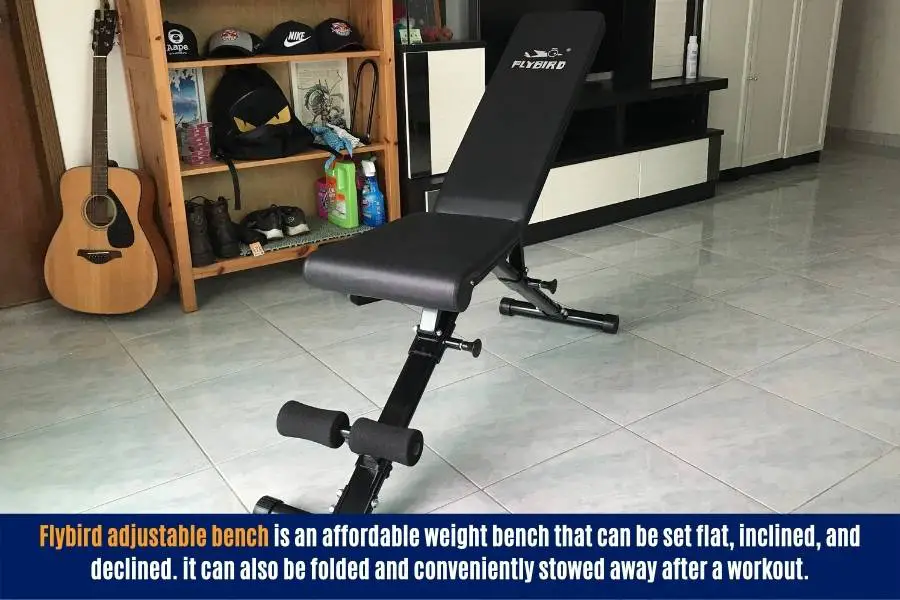
I use the Flybird adjustable bench. It’s an extremely affordable and cost-effective way to train the entire body at home. It can be delivered free of charge from Amazon here (link for the cheapest price).
- Key Points Summary:
- 1) A Piano Bench Is An Ideal Flat Bench Alternative.
- 2) Incline On A Stack Of Sofa Pillows
- 3) Stack Plywood Sheets To Make A Simple Wooden Bench.
- 4) Use The Armrest Of A Couch As A Flat Surface.
- 5) Lay On The Corner Of A Mattress Or Footstool.
- 6) Use A Coffee Table To Bench Press Without A Bench.
- 7) Make A Homemade Bench Using 2 Chairs And Bed Slats.
- 8) Lay Your Back On An Exercise Ball.
- 9) Line-Up Multiple Stools To Create A Makeshift Bench.
- 10) Use A Sack Of Rice Or Sand.
- 11) Use A Reclinable Deck Chair As An Incline Bench.
- 12) Lay On The Flat Side Of A Mini Bookcase.
- 13) Use A Stack Of Books As A Flat Bench Alternative.
- 14) Cut A Log In Half To Make A Flat Bench.
- 15) Lay On The Floor.
- Interested In A Weight Bench?
- Conclusion
1) A Piano Bench Is An Ideal Flat Bench Alternative.
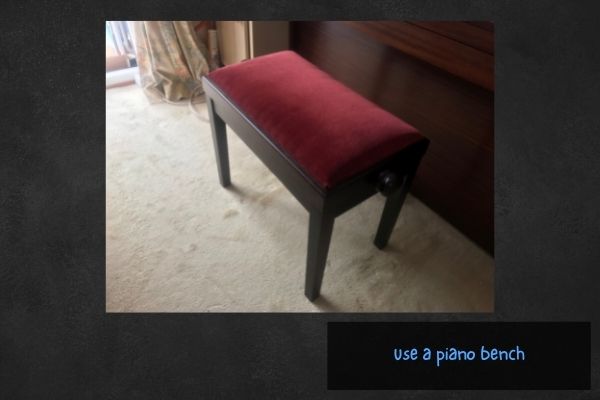
Anything that’s longer than its wide can make a fantastic weight bench alternative.
Dining benches, outdoor benches, and piano benches are all great examples.
But the piano bench, in particular, makes a great makeshift weight bench.
The cushion is usually soft enough to be comfy, but also firm enough to provide support.
They’re also very sturdy and have a good height for your elbows to move freely as you perform the bench press.
One issue you may have with using a piano bench though is with the length since a piano bench is usually shorter than a weight bench.
How to do it:
Lay your back on the piano bench and have your bum hang off. Plant your feet firmly on the ground and actively push your hips upwards. You can do this by contracting your glutes and core. This helps you keep a stable back as you lift your weights.
Top tip:
Taking a wide stance with your feet will make it easier to hold your hips in position!
2) Incline On A Stack Of Sofa Pillows
Pillows and sofa backrests are found in every household. And these can be used as a makeshift incline bench.
All you have to do is stack them and lay your back against the resulting tower.
Though crude, this is one of the safer methods to do the incline bench press without a bench.
It’s generally very stable and the pillows provide good comfort.
How to do it:
Sit your buttocks onto the floor and lean backward onto a tower of pillows. This tower will support your back in the incline position as you lift your weights.
Top tip:
Place the pillows against a stable vertical surface such as a wall. This can prevent the pillow tower from moving or toppling over as you lift!
3) Stack Plywood Sheets To Make A Simple Wooden Bench.
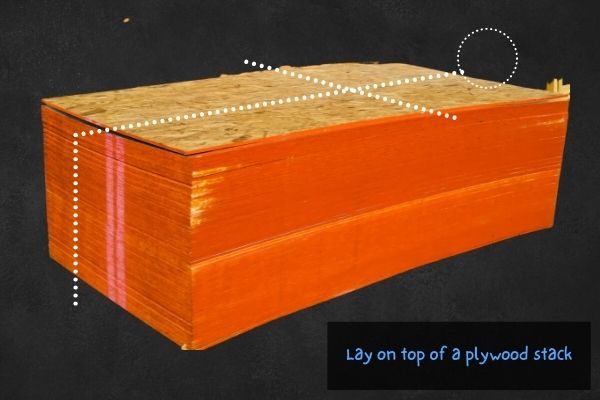
It’s not uncommon for a garage to have sheets of wooden off-cuts lying about.
A simple wooden bench can be made by stacking sheets of plywood. This will form an elevated platform that is both flat and sturdy. The resulting platform can be laid on and used as a flat bench to perform chest exercises.
Those extra few inches of height can be enough to give your arms the range of movement (ROM) required to maximize muscle activation during exercises such as the bench press and chest fly!
How to do it:
Gather as many sheets of plywood or MDF as you can, making sure the edges are sanded down to prevent splinters. Now stack them on the floor until you create a platform that is around 5 to 10 inches thick!
Top tip:
The wooden platform should be long enough to fit the length of your torso, wide enough to accommodate the width of your back, and narrow enough so that it doesn’t get in the way of your elbows. Lay a yoga mat on top to add even more height to the bench and increase comfort.
4) Use The Armrest Of A Couch As A Flat Surface.
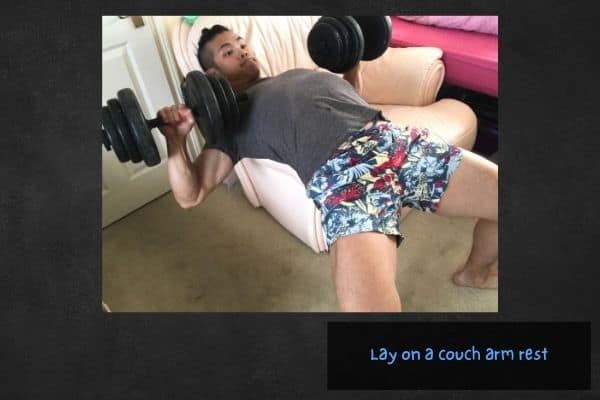
Most couches have an armrest portion which can be used as a weight bench alternative.
Since everyone has a couch, this method is a cost-free way to train your chest without a bench.
However, it can be awkward to lay on.
It really depends on the shape of the armrest (the flatter the better).
You could also try laying on the seat portion of the couch instead.
But the soft seat cushions usually don’t provide good back support.
Additionally, the backrest and armrest would physically restrict your ROM.
Nevertheless, the couch armrest method is one to consider if you don’t have other options!
How to do it:
Lay your upper back on the armrest with your chin tucked in towards your chest to prevent hyperextension of the neck. Now plant your feet onto the couch seat, and raise your hip so it’s in line with your upper back and armrest.
Top tip:
Bend your knees to bring your feet towards the bum and point your knees upwards. This will tuck your lower body close to your upper body, thereby concentrating the center of gravity to keep you stable.
5) Lay On The Corner Of A Mattress Or Footstool.
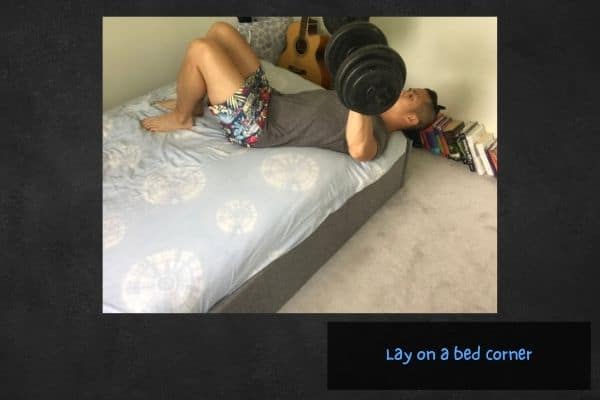
Any large flat surface with an open corner can also be used as a weight bench alternative.
Examples include the corner of a mattress or the detachable footstool of a couch.
Since these objects have free edges (unlike a couch edge which is restricted by a backrest and armrest), your ROM won’t be restricted.
How to do it:
Lay your back on the flat surface of a mattress or footstool, with the corner aligned to the vertical line of your back (i.e. pointing towards your head). Plant the soles of your feet into the floor or the mattress/stool to provide support.
Top tip:
Start with lighter weights. You’re benching on a soft surface that will rock left and right as the cushion warps. Lifting lighter weights will help you to maintain stability.
6) Use A Coffee Table To Bench Press Without A Bench.
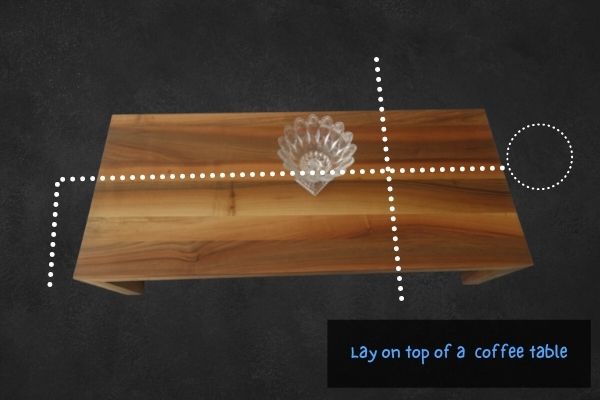
A coffee table can be used to safely bench press at home without a bench. Since a coffee table is long and narrow, it supports the torso and gives the arms a free range of movement. This is ideal for the dumbbell or barbell bench press.
It goes without saying, but you should only do this on solid wooden coffee tables!
Many tables are made from high-density wood and these are perfect to use.
But be careful with low-density lumber or cork.
How to do it:
Use it as you would with a regular weight bench. If the table is shorter than your torso, you can lay your upper back on the table and have your lower body hang from the edge (planting your feet on the ground for support).
Top tip:
Place a yoga mat on top of the table for added comfort. Yoga and camping mats are ideal since they have grip and are firm but supple. Cheap ones like the Balance Form Mat can be delivered quickly from Amazon (click here for the cheapest price).
Carpet cuttings, pillows, or comforters are not recommended because they will slip and slide.
7) Make A Homemade Bench Using 2 Chairs And Bed Slats.
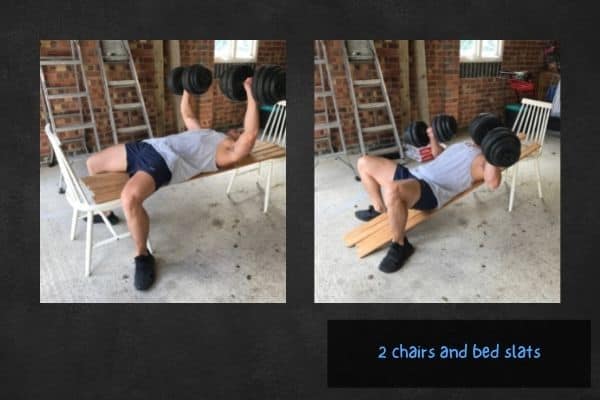
Two chairs and multiple bed slats can be used to make a homemade bench. This can be done by positioning two chairs to face each other and bridging the gap with the bed slats to replicate the structure of a weight bench.
If you don’t have any bed slats, you can also use any type of flat durable wood.
As long as the wood is long enough to accommodate your torso and sturdy enough to handle your weight, it’ll do the job!
How to do it:
Keep the wooden bridge as short as possible to minimize the risk of it snapping. Chairs with gaps in the back support are ideal since the bed slats can protrude from the gaps. This allows you to shorten the length of the wooden bridge by sliding the chairs closer to each other.
Top tip:
Remove one of the chairs and have that side of the bridge rest on the floor whilst the other side remains elevated by the chair. This will create your own incline weight bench alternative!
For more details on the ideal size of a bench backrest, you can check out my other article for the average dimensions of 20 popular weight benches!
8) Lay Your Back On An Exercise Ball.
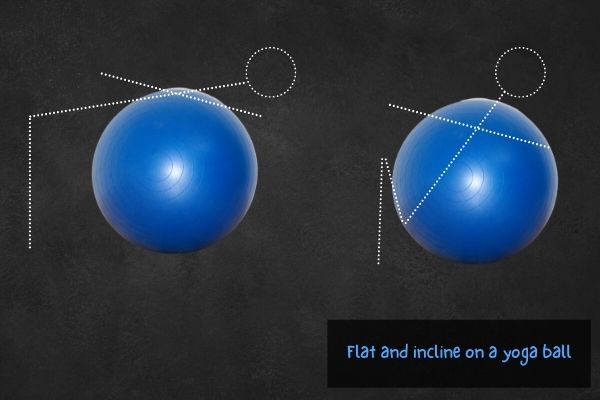
BOSU ball, yoga ball, exercise ball, whatever you want to call them.
These are common in many households. And if you don’t have one lying about, they can be purchased cheaply from Amazon. The Pro Body Pilates ball (check the cheapest price here) is made from a non-rubber PVC material. It doesn’t smell like some of the other exercise balls I’ve used in the past. The material is also firm enough to hold bodyweights up to 250lbs, yet supple enough to be comfortable.
You can even use a space hopper (those giant balls with handles that kids use to bounce around on).
These are all versatile and can be used as a weight bench alternative.
But be careful- they are inherently very unstable.
So start with light weights and progress slowly.
Since they’re unstable, this also makes them excellent for engaging the core whilst you perform your exercises.
That’s because your abs contract to counterbalance the rolling ball.
How to do it:
Imagine piercing the ball with a needle right through to its very center. Your upper back should be laying where the needle would enter the ball (i.e. in the center of the top). Additionally, plant your feet on the ground and raise your hips so your thighs and back are parallel with the ground. This will support the lower body as you lift your weights.
Top tip:
Keep your feet planted with as wide a stance as possible. This helps to keep you stable.
9) Line-Up Multiple Stools To Create A Makeshift Bench.
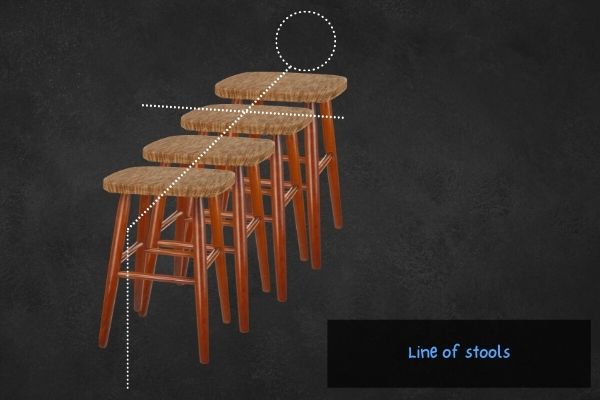
Some garages have unused kitchen stools, bar stools, or kid stools sat gathering dust.
These can be positioned in a line to create an elevated flat surface.
And this can be used as a flat weight bench.
You can also saw off the backs of unused kitchen chairs to create a stool shape.
Whatever you use, just make sure the stools are sturdy and balanced.
The best stools for the job will be made from metal or high-density woods such as oak and maple!
How to do it:
Place 2-4 stools in a straight line. The stools should also be as flat as possible, so avoid using ones that have a backrest as this will get in the way as you lift your weights. Now you can place a yoga mat on top (or anything soft with a good grip).
Top tip:
Stools are often narrow and you don’t want them to become unbalanced and topple over. Make sure the height of the bench allows your feet to be planted firmly on the ground.
Even the best DIY bench is incomparable to the cheapest weight bench. If you’ve got $145 to spend, why not check out my Flybird adjustable bench review. It’s one of the best and cheapest adjustable benches for beginners. It’s also foldable and extremely space-effective!
10) Use A Sack Of Rice Or Sand.
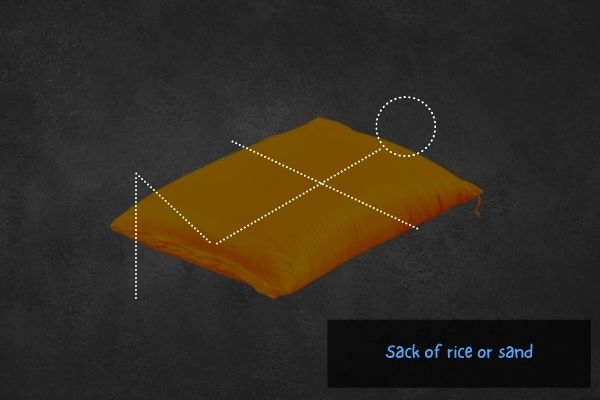
OK not everyone has a 20kg sack of rice or sand at home
But for those who do, these make an extremely safe and effective weight bench alternative.
A sack of rice/sand has the perfect dimensions to be used as a flat weight bench.
It’s wide and long enough to lie comfortably on and it’s also got enough grip to not slide about.
How to do it:
Place a sack of rice or sand on the floor. Now lay your torso on the flat part of the sack. Create a 45° bend at the knees and plant your feet on the ground for stability.
If your butt hangs over the edge of the sack, you can plant your feet on the ground and push your hips upwards to stabilize the body.
Top tip:
Before you start lifting your weights, lay on the sack and wiggle the torso. This forces the individual grains of rice/sand to contour around your back and provide a more stable and comfortable lifting surface.
A bench is no good without weights. Adjustable dumbbells offer a cost and space-effective way to train at home. Check out my other article to find out what to look for in adjustable dumbbells!
11) Use A Reclinable Deck Chair As An Incline Bench.
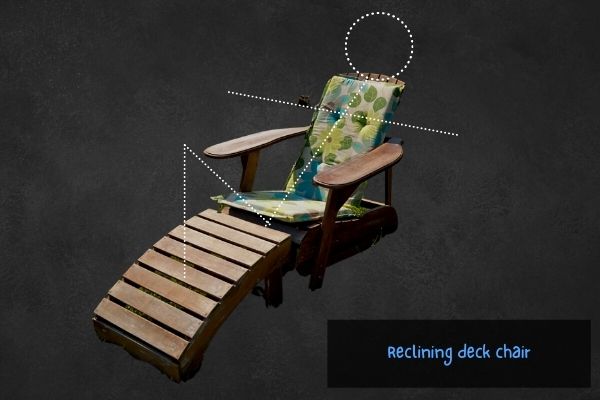
It’s much harder to create a makeshift incline bench than it is to create a flat bench.
But there are household items you can use.
A reclinable deck chair can be used as an incline bench. These can adjust from 0° to 90° and make an effective alternative to an incline bench. However, it is not recommended to exceed the maximum weight capacity for the chair.
This is perfect for incline bench pressing with light dumbbells at higher reps.
But I stress again:
Please. Check. The. Max. Capacity. Of. The. Chair.
How to do it:
Simply set your deck chair at the desired angle and lay on it as you would on a regular incline weight bench.
Top tip:
These chairs aren’t designed to hold the extra weight. Find out the maximum weight capacity of the chair by looking in the manual or Googling the model. Now stay well within the recommended weight capacity! Don’t forget to factor in your body weight as well as the weight of your dumbbells/barbells.
12) Lay On The Flat Side Of A Mini Bookcase.
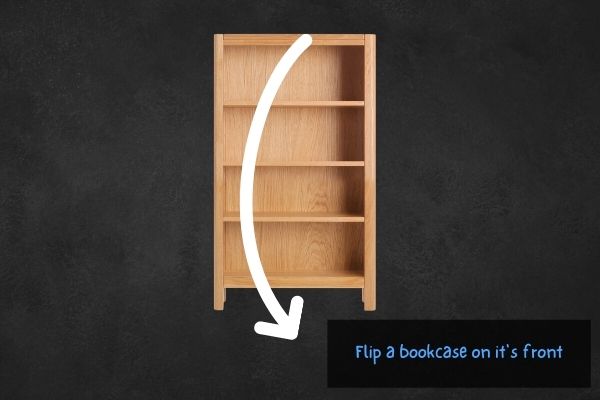
These are popular from Ikea.
They usually stand at around 4 feet tall, 2 feet in width, and 1 foot in depth.
And these are ideal dimensions for a weight bench alternative if you flip it onto the front face.
A couple of CD towers could also work well.
Just make sure the joints are secure and the wood is durable enough to handle your weight.
How to do it:
Empty the bookcase or CD tower and flip it onto its front face. Now you can on the back of it as if you would on a regular bench.
Top tip:
Screw metal L-brackets into the corners to increase the integrity of the joints. This will make your new home weight bench much safer!
Cheap L-brackets can be bought on Amazon and delivered the next day (I recommend these stainless steel brackets).
13) Use A Stack Of Books As A Flat Bench Alternative.
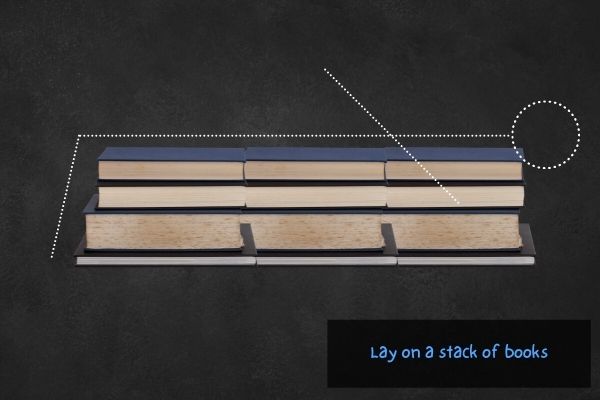
If you don’t have a bookcase, you can also use the actual books themselves.
When stacked on top of each other and weight is applied, the surface of the books will generate friction.
And this creates a safe and stable surface to lift your weights since you won’t be sliding about.
Books can handle any weight you throw at them and you’d be surprised at how effective this method is!
How to do it:
Determine how many books are required to create a width that can accommodate your frame. Now begin stacking the books to around 1-foot height. Around 50 books will do the job!
Top tip:
Lay the books like brickwork. In other words, the flat surface of one book should always bridge the gap formed between the two books below it. This creates a stable stack for your new gym bench alternative!
It’s important to consider the correct height for a bench to be safe and effective. Find out how tall a weight bench should be in my other article.
14) Cut A Log In Half To Make A Flat Bench.
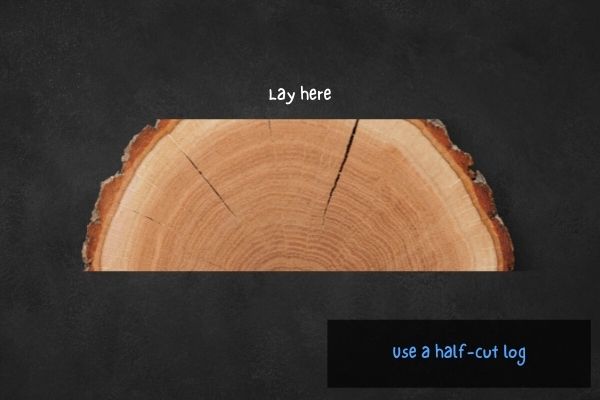
Ok now we’re getting into really unconventional territories, but hear me out.
If you live in a forested area or you have one in your backyard, you can use a log to create a homemade weight bench.
When made properly, this is one of the safest and coolest-looking home gym bench alternatives you can make.
The bigger the log, the more stable and safer it will be!
But the obvious caveat to using this method is the lack of transportability.
How to do it:
Lay the log on its longest side. Now saw the log in half lengthways to create a semi-circular log. The flat side of the semi-circle will be the face that lies flat on the floor. Now saw the log lengthways again, but this time a few inches from the top of the log. This will create the flat surface of your new bench.
Top tip:
Though stable, this bench will not be comfortable. Nail some carpet cuttings onto the flat face of the log to create makeshift padding.
15) Lay On The Floor.
There’s nothing wrong with keeping things simple.
And it doesn’t get much simpler than just laying on the floor!
This is a safe and effective way to bench press at home without a bench.
In fact, there’s even a name for it- the floor press.
The reduced ROM is the main downside of bench pressing on the floor rather than on a bench.
You won’t get maximum chest activation since the floor prevents your elbows from going below the torso.
However, the upside is that floor pressing promotes maximal pressing strength since you can’t cheat by using leg drive or body momentum to help you press the dumbbell or barbell.
You can also try the dumbbell floor fly as an alternative to the regular dumbbell chest fly.
How to do it:
Lay on the floor with your feet planted into the ground and the knees pointing upwards. Perform your chosen exercise on the floor, as you would on a bench.
Top tip:
One of the biggest benefits of bench pressing on an actual bench is that it allows you to maintain a solid foot-floor connection and maximize stability. You should replicate this during the floor press by really digging your feet into the ground as you lift your weights.
The floor press and floor fly are great if you don’t have a bench. But using a bench will always get you better training results. Check out my other article to find out why you should get a bench for your dumbbells!
Interested In A Weight Bench?
| Bench | Brand | Description | Prime | Buy |
|---|---|---|---|---|
Top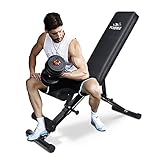 Top
Top
Top
Top
Top Top
Top
Top
Top
Top | Flybird | Fully-adjustable (flat/incline/decline) weight bench that can be folded for storage. Good for people 6'0 and over | PrimeEligible | Check Amazon Price |
 | Flybird | Cheapest Flybird bench model. Lower build-quality and height makes it good for beginners and people under 6'0 | PrimeEligible | Check Amazon Price |
 Top
Top
Top
Top
Top Top
Top
Top
Top
Top | Fitness Reality | Fully-adjustable (flat/incline/decline) weight bench that can be folded for storage. Good for people under 6'0 | PrimeEligible | Check Amazon Price |
 Top
Top
Top
Top
Top
Top | PowerBlock | BEST heavy adjustable dumbbell on the market to go with the Flybird bench | PrimeEligible | Check Amazon Price |
 Top
Top
Top
Top
Top
Top | Yes4All | BUDGET alternative dumbbell to go with the Flybird bench | PrimeEligible | Check Amazon Price |
Conclusion
I’ve shared 15 ideas for a weight bench alternative anyone can try at home.
Most of these ideas use common household objects, so you should be able to try a few of them relatively hassle-free.
Whichever method you decide to try though, please be safe.
Make sure your DIY bench is flat, stable, and has a good grip.
A DIY bench should also be as low-lying as possible to minimize injury in case you do fall off. You can also try adding some pillows around potential fall areas for extra safety.
Remember- even the best DIY weight bench is still incomparable to the cheapest weight bench.
If you’re regularly training the chest at home, then I’d strongly recommend investing 100 bucks to get a proper bench (check out my other article to find out exactly how much a weight bench should cost).
Which weight bench alternative will you be trying?
Let me know in the comments!
You may also be interested in the downloadable Kalibre Blueprint PDF which details exactly how I gained 40lbs of lean muscle (it’s 100% free!). It gives the exact exercises and nutrition I used to go from skinny to ripped!
Thanks for reading guys!
Peace Out,
Kal
(Biochemistry BSc, Biomedical Sciences MSc, Ex-Skinny Guy)


